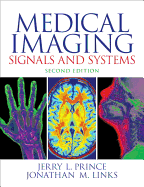Instant download Solutions Manual for Medical Imaging Signals and Systems 2e by Prince 0132145189 pdf docx epub after payment.

Product details:
- ISBN-10 : 0132145189
- ISBN-13 : 978-0132145183
- Author:
This text is designed for courses in medical imaging systems. It is also suitable for professionals seeking an overview of medical imaging systems.
With signal processing as its foundation, Medical Imaging Signals and Systems, Second Edition covers the most important imaging modalities in radiology: projection radiography, x-ray computed tomography, nuclear medicine, ultrasound imaging, and magnetic resonance imaging. Organized into parts to emphasize key overall conceptual divisions, Medical Imaging is most appropriate for engineering students who have taken the prerequisite signals and systems courses as well as elementary probability.
Table of contents:
Part I Basic Imaging Principles 1
1 Introduction 5
1.1 History of Medical Imaging 5
1.2 Physical Signals 6
1.3 Imaging Modalities 7
1.4 Projection Radiography 7
1.5 Computed Tomography 9
1.6 Nuclear Medicine 10
1.7 Ultrasound Imaging 11
1.8 Magnetic Resonance Imaging 12
1.9 Multimodality Imaging 13
1.10 Summary and Key Concepts 13
2 Signals and Systems 15
2.1 Introduction 15
2.2 Signals 16
2.2.1 Point Impulse 16
2.2.2 Line Impulse 19
2.2.3 Comb and Sampling Functions 19
2.2.4 Rect and Sinc Functions 20
2.2.5 Exponential and Sinusoidal Signals 22
2.2.6 Separable Signals 23
2.2.7 Periodic Signals 23
2.3 Systems 24
2.3.1 Linear Systems 24
2.3.2 Impulse Response 25
2.3.3 Shift Invariance 25
2.3.4 Connections of LSI Systems 28
2.3.5 Separable Systems 30
2.3.6 Stable Systems 31
2.4 The Fourier Transform 31
2.5 Properties of the Fourier Transform 36
2.5.1 Linearity 36
2.5.2 Translation 37
2.5.3 Conjugation and Conjugate Symmetry 37
2.5.4 Scaling 37
2.5.5 Rotation 38
2.5.6 Convolution 38
2.5.7 Product 39
2.5.8 Separable Product 40
2.5.9 Parseval’s Theorem 40
2.5.10 Separability 40
2.6 Transfer Function 41
2.7 Circular Symmetry and the Hankel Transform 43
2.8 Summary and Key Concepts 47
3 Image Quality 54
3.1 Introduction 54
3.2 Contrast 55
3.2.1 Modulation 56
3.2.2 Modulation Transfer Function 56
3.2.3 Local Contrast 60
3.3 Resolution 61
3.3.1 Line Spread Function 61
3.3.2 Full Width at Half Maximum 62
3.3.3 Resolution and Modulation Transfer Function 63
3.3.4 Subsystem Cascade 65
3.3.5 Resolution Tool 68
3.3.6 Temporal and Spectral Resolution 68
3.4 Noise 69
3.4.1 Random Variables 70
3.4.2 Continuous Random Variables 70
3.4.3 Discrete Random Variables 72
3.4.4 Independent Random Variables 75
3.5 Signal-to-Noise Ratio 76
3.5.1 Amplitude SNR 77
3.5.2 Power SNR 77
3.5.3 Differential SNR 79
3.5.4 Decibels 80
3.6 Sampling 80
3.6.1 Signal Model for Sampling 81
3.6.2 Nyquist Sampling Theorem 83
3.6.3 Anti-Aliasing Filters 85
3.7 Other Effects 86
3.7.1 Artifacts 86
3.7.2 Distortion 88
3.8 Accuracy 88
3.8.1 Quantitative Accuracy 89
3.8.2 Diagnostic Accuracy 89
3.9 Summary and Key Concepts 92
Part II Radiographic Imaging 101
4 Physics of Radiography 106
4.1 Introduction 106
4.2 Ionization 107
4.2.1 Atomic Structure 107
4.2.2 Electron Binding Energy 109
4.2.3 Ionization and Excitation 109
4.3 Forms of Ionizing Radiation 110
4.3.1 Particulate Radiation 110
4.3.2 Electromagnetic Radiation 112
4.4 Nature and Properties of Ionizing Radiation 113
4.4.1 Primary Energetic Electron Interactions 114
4.4.2 Primary Electromagnetic Radiation Interactions 116
4.5 Attenuation of Electromagnetic Radiation 120
4.5.1 Measures of X-Ray Beam Strength 121
4.5.2 Narrow Beam, Monoenergetic Photons 123
4.5.3 Narrow Beam, Polyenergetic Photons 125
4.5.4 Broad Beam Case 127
4.6 Radiation Dosimetry 127
4.6.1 Exposure 127
4.6.2 Dose and Kerma 128
4.6.3 Linear Energy Transfer (LET) 128
4.6.4 The f -Factor 128
4.6.5 Dose Equivalent 129
4.6.6 Effective Dose 130
4.7 Summary and Key Concepts 131
5 Projection Radiography 135
5.1 Introduction 135
5.2 Instrumentation 136
5.2.1 X-Ray Tubes 136
5.2.2 Filtration and Restriction 139
5.2.3 Compensation Filters and Contrast Agents 141
5.2.4 Grids, Airgaps, and Scanning Slits 143
5.2.5 Film-Screen Detectors 146
5.2.6 X-Ray Image Intensifiers 148
5.2.7 Digital Radiography 149
5.2.8 Mammography 154
5.3 Image Formation 154
5.3.1 Basic Imaging Equation 154
5.3.2 Geometric Effects 155
5.3.3 Blurring Effects 162
5.3.4 Film Characteristics 166
5.4 Noise and Scattering 169
5.4.1 Signal-to-Noise Ratio 169
5.4.2 Quantum Efficiency and Detective Quantum Efficiency 171
5.4.3 Compton Scattering 173
5.5 Summary and Key Concepts 175
6 Computed Tomography 186
6.1 Introduction 186
6.2 CT Instrumentation 188
6.2.1 CT Generations 188
6.2.2 X-Ray Source and Collimation 194
6.2.3 Dual-Energy CT 194
6.2.4 CT Detectors 195
6.2.5 Gantry, Slip Ring, and Patient Table 196
6.3 Image Formation 197
6.3.1 Line Integrals 197
6.3.2 CT Numbers 198
6.3.3 Parallel-Ray Reconstruction 198
6.3.4 Fan-Beam Reconstruction 208
6.3.5 Helical CT Reconstruction 212
6.3.6 Cone Beam CT 213
6.3.7 Iterative Reconstruction 213
6.4 Image Quality in CT 213
6.4.1 Resolution 214
6.4.2 Noise 216
6.4.3 Artifacts 221
6.5 Summary and Key Points 223
Part III Nuclear Medicine Imaging 235
7 The Physics of Nuclear Medicine 239
7.1 Introduction 239
7.2 Nomenclature 240
7.3 Radioactive Decay 240
7.3.1 Mass Defect and Binding Energy 240
7.3.2 Line of Stability 242
7.3.3 Radioactivity 243
7.3.4 Radioactive Decay Law 243
7.4 Modes of Decay 245
7.4.1 Positron Decay and Electron Capture 245
7.4.2 Isomeric Transition 246
7.5 Statistics of Decay 247
7.6 Radiotracers 249
7.7 Summary and Key Concepts 251
8 Planar Scintigraphy 255
8.1 Introduction 255
8.2 Instrumentation 255
8.2.1 Collimators 256
8.2.2 Scintillation Crystal 258
8.2.3 Photomultiplier Tubes 258
8.2.4 Positioning Logic 260
8.2.5 Pulse Height Analyzer 260
8.2.6 Gating Circuit 262
8.2.7 Image Capture 263
8.2.8 Solid State and Other New Cameras 264
8.3 Image Formation 264
8.3.1 Event Position Estimation 264
8.3.2 Acquisition Modes 266
8.3.3 Anger Camera Imaging Equation 269
8.4 Image Quality 272
8.4.1 Resolution 273
8.4.2 Sensitivity 276
8.4.3 Uniformity 278
8.4.4 Energy Resolution 279
8.4.5 Noise 280
8.4.6 Factors Affecting Count Rate 281
8.5 Summary and Key Concepts 282
9 Emission Computed Tomography 293
9.1 Instrumentation 294
9.1.1 SPECT Instrumentation 294
9.1.2 PET Instrumentation 298
9.2 Image Formation 304
9.2.1 SPECT Image Formation 304
9.2.2 PET Image Formation 309
9.2.3 Iterative Reconstruction 313
9.3 Image Quality in SPECT and PET 317
9.3.1 Spatial Resolution 318
9.3.2 Attenuation and Scatter 319
9.3.3 Random Coincidences 320
9.3.4 Contrast 320
9.3.5 Noise and Signal-to-Noise Ratio 321
9.4 Summary and Key Concepts 321
Part IV Ultrasound Imaging 331
10 The Physics of Ultrasound 335
10.1 Introduction 335
10.2 The Wave Equation 336
10.2.1 Three-Dimensional Acoustic Waves 336
10.2.2 Plane Waves 338
10.2.3 Spherical Waves 340
10.3 Wave Propagation 341
10.3.1 Acoustic Energy and Intensity 341
10.3.2 Reflection and Refraction at Plane Interfaces 342
10.3.3 Transmission and Reflection Coefficients at Plane Interfaces 343
10.3.4 Attenuation 344
10.3.5 Scattering 347
10.3.6 Nonlinear Wave Propagation 347
10.4 Doppler Effect 349
10.5 Beam Pattern Formation and Focusing 353
10.5.1 Simple Field Pattern Model 354
10.5.2 Diffraction Formulation 355
10.5.3 Focusing 361
10.6 Summary and Key Concepts 362
11 Ultrasound Imaging Systems 367
11.1 Introduction 367
11.2 Instrumentation 367
11.2.1 Ultrasound Transducer 367
11.2.2 Ultrasound Probes 372
11.3 Pulse-Echo Imaging 374
11.3.1 The Pulse-Echo Equation 374
11.4 Transducer Motion 377
11.5 Ultrasound Imaging Modes 380
11.5.1 A-Mode Scan 380
11.5.2 M-Mode Scan 381
11.5.3 B-Mode Scan 381
11.6 Steering and Focusing 386
11.6.1 Transmit Steering and Focusing 386
11.6.2 Beamforming and Dynamic Focusing 388
11.7 Three-Dimensional Ultrasound Imaging 391
11.8 Image Quality 392
11.8.1 Resolution 392
11.8.2 Noise and Speckle 395
11.9 Summary and Key Concepts 396
Part V Magnetic Resonance Imaging 407
12 Physics of Magnetic Resonance 410
12.1 Introduction 410
12.2 Microscopic Magnetization 410
12.3 Macroscopic Magnetization 412
12.4 Precession and Larmor Frequency 414
12.5 Transverse and Longitudinal Magnetization 416
12.5.1 NMR Signals 417
12.5.2 Rotating Frame 419
12.6 RF Excitation 419
12.7 Relaxation 422
12.8 The Bloch Equations 425
12.9 Spin Echoes 426
12.10 Basic Contrast Mechanisms 429
12.11 Summary and Key Concepts 433
13 Magnetic Resonance Imaging 439
13.1 Instrumentation 439
13.1.1 System Components 439
13.1.2 Magnet 441
13.1.3 Gradient Coils 442
13.1.4 Radio Frequency Coils 445
13.1.5 Scanning Console and Computer 446
13.2 MRI Data Acquisition 447
13.2.1 Encoding Spatial Position 447
13.2.2 Slice Selection 449
13.2.3 Frequency Encoding 455
13.2.4 Polar Scanning 460
13.2.5 Gradient Echoes 461
13.2.6 Phase Encoding 462
13.2.7 Spin Echoes 465
13.2.8 Pulse Repetition Interval 467
13.2.9 Realistic Pulse Sequences 467
13.3 Image Reconstruction 469
13.3.1 Rectilinear Data 470
13.3.2 Polar Data 471
13.3.3 Imaging Equations 472
13.4 Image Quality 475
13.4.1 Sampling 475
13.4.2 Resolution 477
13.4.3 Noise 479
13.4.4 Signal-to-Noise Ratio 481
13.4.5 Artifacts 482
13.5 Advanced Contrast Mechanisms 483
13.6 Summary and Key Concepts 487
Index 497
People also search:
Medical Imaging Signals and Systems 2nd edition
Medical Imaging Signals and Systems 2nd edition pdf
Medical Imaging Signals and Systems
what is the purpose of medical imaging
prince and links medical imaging signals and systems
what is considered medical imaging





